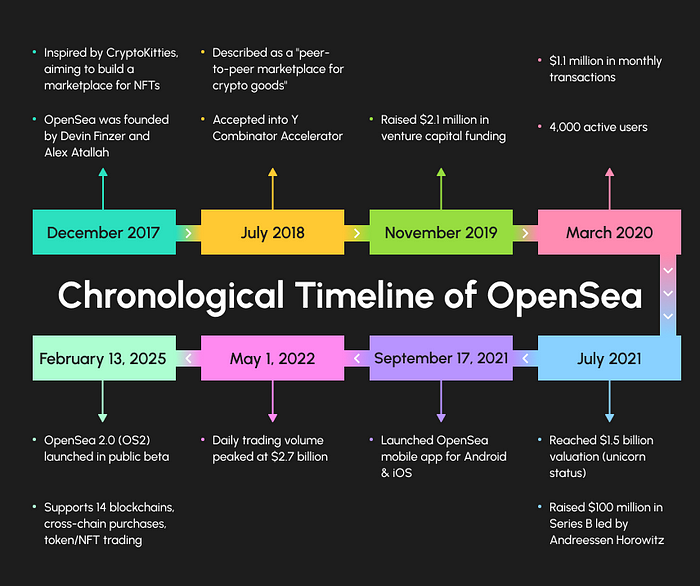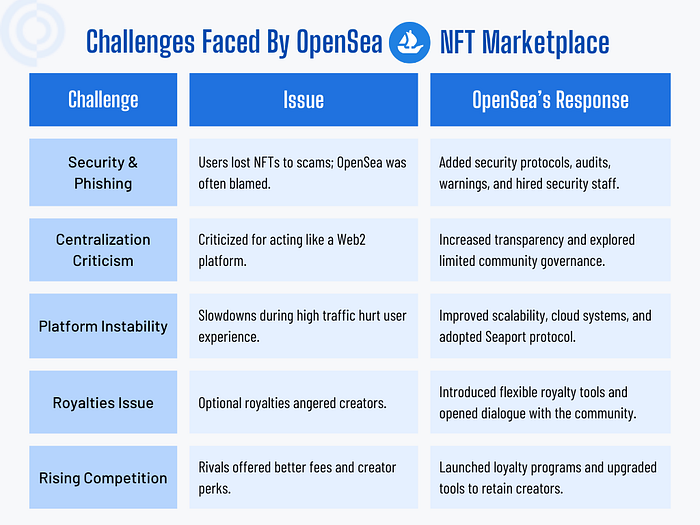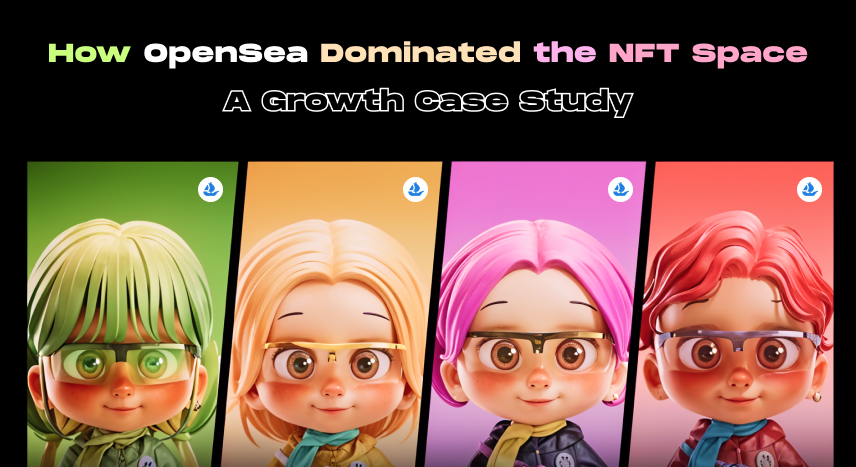
The New York Times once described OpenSea as “one of the most talked-about blockchain start-ups in Silicon Valley”.
Soon, it had become the go-to marketplace for NFTs, gaining nicknames such as ‘the Amazon of digital assets’ and ‘the eBay of crypto collectibles.
As NFTs burst into the mainstream, turning memes, digital art, and even tweets into million-dollar assets, OpenSea became the platform fueling this digital gold rush. With lots of unique strategies, OpenSea positioned itself not only as a marketplace but as the backbone of the NFT economy.
This case study examines OpenSea’s meteoric ascent, breaking down its strengths, challenges, distinct market position, and the strategies that enabled it to succeed in the dynamic life of Web3.
OpenSea began simply in the early days of blockchain. The founders predicted that digital ownership was going to be a big thing. They were inspired by initiatives such as CryptoKitties and envisioned a decentralized platform. They aimed to create a space where anyone could mint, sell, and purchase NFTs without the need for middlemen. As individuals were still adapting to digital collectibles, OpenSea quietly established the groundwork for a major shift in the way we perceive ownership online.
- Founded — December 2017
- Founders — Alex Atallah and Devin Finzer
- Headquarters — New York, USA
- Initial Funding — $2 million seed round led by Founders Fund and 1 confirmation
- Blockchain Support — Ethereum (initially), later added Polygon, Klaytn, Arbitrum, and more
- Core Product — Peer-to-peer marketplace for NFTs such as digital art, collectibles, domain names, virtual worlds, and more

This chart shows us the chronological growth of OpenSea as a leading NFT Marketplace. But how, exactly, did OpenSea transition from a small crypto startup to the leading player in a multi-billion-dollar market? Let’s dissect the strategies and moments that positioned it at the forefront of the NFT revolution.
Before OpenSea’s arrival, the NFT ecosystem was scattered and mostly experimental. CryptoPunks and CryptoKitties were early winners, but there was no unified, user-friendly platform to browse, trade, or collect these digital goods.
Purchasing an NFT typically involves technical expertise, including several wallets, smart contracts, and cumbersome interfaces. There was a disconnect between creators, collectors, and ease of use. This is where OpenSea seized the moment.
OpenSea stood out as the very first peer-to-peer NFT platform to list a diverse array of digital assets under one roof. It accommodated various categories of NFTs like art, collectibles, in-game items, virtual real estate, and domain names. It even enabled users to create their own NFTs with zero coding required.
Its integration with Ethereum, support for ERC-721 and ERC-1155 tokens, and ease of use made the NFT trade accessible to all. Gas-free transactions on Polygon, customizable storefronts, and analytics tools make both creators and collectors successful. OpenSea was not only constructing a platform it also molded an ecosystem.
So what fueled OpenSea’s rocket growth in such an uncertain and testing space? To figure that out, we have to strip away the strength of OpenSea.
OpenSea’s rise to dominance in the NFT market wasn’t just about being early, it was about doing the right things at the right time. From user experience to community engagement, the platform aimed to make NFTs accessible, scalable, and rewarding for creators and collectors alike. The following are the most important factors that formed the pillars of OpenSea’s success.
First-Mover Advantage
OpenSea came into use when NFTs were in the experimental phase, providing it with a substantial lead in terms of capturing market share. Being ahead allowed OpenSea to establish foundational connections with creators, collectors, and developers. It also provided the platform with the time to iterate and refine itself before the NFT hype of 2021, making it a preferred name for NFT trading.
User-Friendly Interface
Unlike other crypto platforms packed with technical language and cumbersome processes, OpenSea’s UX was designed for simplicity. Direct wallet integration (e.g., MetaMask), transparent pricing, and intuitive filter-to-navigate functionality facilitated onboarding millions of users who had no prior experience with blockchain.
Multi-Chain Support
OpenSea’s compatibility with Mutliple networks such as Polygon, Arbitrum, and Klaytn enabled NFT trading with lower gas prices and quicker transactions. This assisted in minimizing entry barriers, particularly for those in parts of the world with high gas prices or lower crypto exposure.
Open Ecosystem for Creators
OpenSea uses an open model that allows anyone to create and sell NFTs. This approach attracts a wide range of creators, from individual digital artists to large brands. As a result, the platform has a growing collection of content. Creators can customize their own storefronts, analyze their collections, and set up royalties, which helps them earn money on their own terms.
Strong Community & Strategic Partnerships
OpenSea built a strong community and partnered with popular NFT projects like Bored Ape Yacht Club, Doodles, and Decentraland. They kept people engaged through social interactions, community AMAs, and Discord server integration, allowing creators to connect directly with their audiences.
As a True Product Marketplace
Unlike platforms that focus only on art or collectibles, OpenSea offers a wide range of NFTs, including art, gaming assets, domain names, music, and virtual property. This variety attracts a broad user base and makes OpenSea a valuable all-in-one NFT store.
Innovative Features & Customization
OpenSea regularly introduced new features, such as gas-free listing on Polygon, lazy minting, bidding systems, and advanced analytics for tracking price history and trends. These features helped users make informed decisions and increased engagement on the platform.
Revenue Model & Scalability
OpenSea’s simple business model charges a 2.5% commission on every transaction. This model scaled up quickly as NFT trading grew. Unlike subscription or curated platforms, OpenSea’s success is directly linked to its users’ success, generating billions in revenue and allowing for investment in platform upgrades and infrastructure.
These strengths not only helped OpenSea dominate the market but also built a strong brand that users returned to, even during difficult times. However, with success, OpenSea has faced various issues in the ever-changing world of Web3.
As the NFT market hype faded, OpenSea faced many new challenges, including technical challenges to increasing competition, and trust issues among users. These continuous issues made it harder to stay on top. However, OpenSea’s ability to learn and adapt has helped it keep its leadership in the changing Web3 space.
Here are some of the major challenges OpenSea faced and how it overcame them.

Despite these obstacles, OpenSea has managed to maintain its edge in a saturated market. So what truly makes OpenSea stand out from its growing list of competitors?
Let’s take a look at…
In the Ocean of NFT Marketplaces, OpenSea becomes the leading NFT marketplace. It gained a large and loyal customer base before the NFT boom, making it the top choice for developers and collectors.
Unlike other platforms that target niche audiences, like Blur for professional traders or Magic Eden for gaming assets, OpenSea appeals to a broad audience by supporting multiple NFT categories across different blockchains. Its simple interface and easy minting process make it friendly for new users, strengthening its popularity.
What sets OpenSea apart is its ability to adapt to market changes. When competitors introduced zero-fee models or better trader rewards, OpenSea responded with new features, loyalty perks, and improved tools for creators. It successfully balanced keeping royalties while remaining competitive by listening to its community and adjusting its policies.
Despite increasing competition, OpenSea remains committed to being an open, creator-focused, and accessible platform, setting an example for NFT marketplaces worldwide. Also, makes the platform a role model for aspiring startups who want to create an NFT Marketplace.
Originating as a small startup, OpenSea became the top NFT marketplace, setting the standard for others to emulate. For startup entrepreneurs considering venturing into the NFT arena, OpenSea is not only inspirational but it is a tried-and-tested blueprint to achieve success.
Here’s how OpenSea became the ultimate business model for creating an NFT marketplace.
1. Created a Platform, Not Just a Product
OpenSea aimed to empower users instead of just offering NFT content. It built a decentralized marketplace where collectors and creators can thrive without restrictions. This openness allowed the platform to grow easily.
2. Made Blockchain Easy to Use
OpenSea tackled one of the biggest challenges for Web3: complexity. It simplified everything from connecting wallets to minting NFTs, making it easy for anyone, even those without tech skills. This user-friendliness became a major advantage.
3. Grew Revenue with the Market
OpenSea charged a 2.5% transaction fee, which was low enough to attract users and flexible enough to generate significant revenue as trading increased. This approach showed that profitability and accessibility can go hand in hand.
4. Prioritized Creators
OpenSea gave creators the tools and freedom they needed, like customizable stores, control over royalties, and flexible listing options. By supporting creators instead of controlling them, it built loyalty and kept a wide range of content on the platform.
5. Supported Many Blockchains and Niches
Instead of sticking to one blockchain or type of NFT, OpenSea welcomed a variety of options, from art and music to games and domains. This adaptable strategy helped attract a broader audience and stay resilient to industry changes.
6. Focused on Community and Transparency
OpenSea didn’t just create a marketplace, it built a community. By encouraging open communication, forming partnerships, and adding features that benefit users, it established trust and generated growth through word-of-mouth.
OpenSea’s success demonstrates that the winning playbook in Web3 is not so much about technology, but it’s about trust, openness, and good execution.
The message for startups is clear: enable others, streamline the user experience, and keep in lockstep with the community.
OpenSea is endeavoring to be at the forefront of the decentralized web. Web3 is constantly changing, but it wants to be more than a marketplace. It wants to be a metacenter of digital ownership in various chains, platforms, and industries.
1. Emphasis on Decentralization
OpenSea is also looking into how to be more decentralized. This involves researching on-chain governance, providing creators with more autonomy, and creating open protocols. The aim is to empower the community while maintaining security and trust.
2. Multi-Blockchain Support
Recognizing that NFTs can be dispersed across multiple platforms, OpenSea is expanding support for multiple blockchains such as Arbitrum, Base, and Solana. This enables users to seamlessly switch between various ecosystems without needing to change platforms.
3. Improving Gaming and Interactive NFTs
OpenSea is witnessing increased interest in blockchain gaming. It launches dynamic NFTs like items, avatars, and land property that are needed for play-to-earn and metaverse activities. This increases possibilities and makes it more accessible to users.
4. More Tools for Creators and Collectors
The platform is launching new analytics, customizable storefronts, and automatic royalty tools. These will allow creators and collectors to make smarter, more assured decisions.
5. Creating a Stronger Infrastructure
OpenSea is transitioning to more efficient protocols such as Seaport. This will lower gas fees, make things faster, and enable the platform to scale to accommodate future demand. This transition paves the way for long-term growth and facilitates easier entry for new users.
As digital ownership continues to grow, OpenSea is transforming from a basic marketplace into a central component of the Web3 ecosystem.
OpenSea expanded from a startup into the leading NFT marketplace by being at the right place at the right time and by earning trust. Its early mover advantage, user-centricity, and creator support contributed to defining the NFT ecosystem. For Web3 founders and startups, OpenSea shows us that being open, easy, and community-driven fuels growth. For creators, it reminds us that platforms made for them can enhance their success.
Now, startups interested in creating their own NFT marketplaces can do so more easily with the help of OpenSea Clone solutions provided by top OpenSea clone script providers. These pre-built platforms enable new businesses to start quickly with functionalities similar to OpenSea, yet with some scope for innovation and customization as well.
As NFTs grow and develop, OpenSea continues to be both the leader and guide, and its model is now more accessible than ever for creators who are prepared to build the next giant thing.
